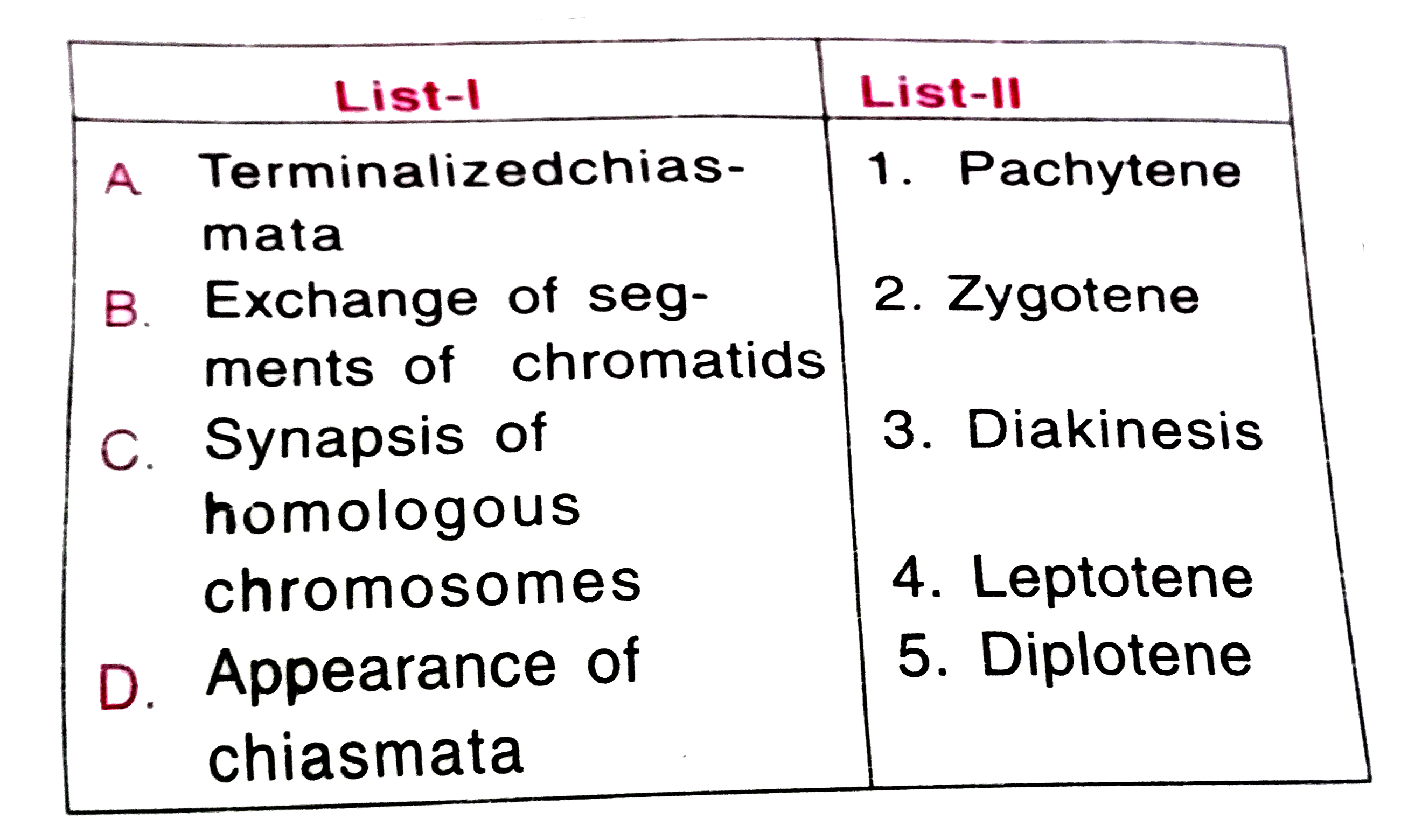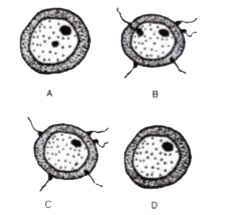(i) Thin thread like chromosomes with a beaded appearance
(ii) Appearance of recombination nodules
(iii) Formation of bivalents/tetrads
(iv) Terminalisation of chiasmata
(v) Appearance of chiasmata
Identify the different stages with respect to the above given features and select the correct option.
(i)(ii)(iii)(iv)(v)LeptoteneZygotenePachyteneDiploteneDiakinesis
(i)(ii)(iii)(iv)(v)LeptoteneZygotenePachyteneDiakinesisDiplotene
(i)(ii)(iii)(iv)(v)LeptotenePachyteneZygoteneDiakinesisDiplotene
(i)(ii)(iii)(iv)(v)LeptotenePachyteneDiploteneZygoteneDiakinesis
The correct Answer is:C
To identify the different stages of meiosis based on the given features, we will analyze each feature step by step and determine the corresponding stage of meiosis.
1. Thin thread-like chromosomes with a beaded appearance:
- This feature is observed during the Leptotene stage of prophase I of meiosis. During this stage, chromosomes begin to condense and can be seen as thin, thread-like structures. The "beaded appearance" refers to the chromatin being organized into distinct units, which are the individual chromosomes.
2. Appearance of recombination nodules:
- Recombination nodules appear during the Pachytene stage. This is the stage where crossing over occurs, and the nodules represent the sites where genetic material is exchanged between homologous chromosomes.
3. Formation of bivalents/tetrads:
- The formation of bivalents (or tetrads) occurs in the Zygotene stage. During this stage, homologous chromosomes pair up closely along their lengths, forming structures known as bivalents or tetrads.
4. Terminalization of chiasmata:
- Terminalization of chiasmata takes place during the Dikinesis stage. This is the final stage of prophase I, where the chiasmata (the points of crossing over) move towards the ends of the chromosomes, preparing for separation.
5. Appearance of chiasmata:
- The appearance of chiasmata is observed during the Diplotene stage. In this stage, the homologous chromosomes begin to separate but remain connected at the chiasmata, which are visible as X-shaped structures.
Summary of Stages:
- (i) Leptotene
- (ii) Pachytene
- (iii) Zygotene
- (iv) Dikinesis
- (v) Diplotene
Final Answer:
1. Leptotene
2. Pachytene
3. Zygotene
4. Dikinesis
5. Diplotene
---
- This feature is observed during the Leptotene stage of prophase I of meiosis. During this stage, chromosomes begin to condense and can be seen as thin, thread-like structures. The "beaded appearance" refers to the chromatin being organized into distinct units, which are the individual chromosomes.
- Recombination nodules appear during the Pachytene stage. This is the stage where crossing over occurs, and the nodules represent the sites where genetic material is exchanged between homologous chromosomes.
- The formation of bivalents (or tetrads) occurs in the Zygotene stage. During this stage, homologous chromosomes pair up closely along their lengths, forming structures known as bivalents or tetrads.
- Terminalization of chiasmata takes place during the Dikinesis stage. This is the final stage of prophase I, where the chiasmata (the points of crossing over) move towards the ends of the chromosomes, preparing for separation.
- The appearance of chiasmata is observed during the Diplotene stage. In this stage, the homologous chromosomes begin to separate but remain connected at the chiasmata, which are visible as X-shaped structures.
- (i) Leptotene
- (ii) Pachytene
- (iii) Zygotene
- (iv) Dikinesis
- (v) Diplotene
1. Leptotene
2. Pachytene
3. Zygotene
4. Dikinesis
5. Diplotene
Topper's Solved these Questions
- BOOK - NCERT FINGERTPS ENGLISHCHAPTER - CELL CYCLE AND CELL DIVISIONEXERCISE - NCERT10videos
CELL CYCLE AND CELL DIVISION
- BOOK - NCERT FINGERTPS ENGLISHCHAPTER - CELL CYCLE AND CELL DIVISIONEXERCISE - CORNER15videos
CELL CYCLE AND CELL DIVISION
- BOOK - NCERT FINGERTPS ENGLISHCHAPTER - CELL CYCLE AND CELL DIVISIONEXERCISE - MITOSIS37videos
CELL CYCLE AND CELL DIVISION
- BOOK - NCERT FINGERTPS ENGLISHCHAPTER - CELL - THE UNIT OF LIFEEXERCISE - Cell - The Unit Of Life159videos
CELL - THE UNIT OF LIFE
- BOOK - NCERT FINGERTPS ENGLISHCHAPTER - CHEMICAL COORDINATION AND INTEGRATIONEXERCISE - All Questions126videos
CHEMICAL COORDINATION AND INTEGRATION
Similar Questions
(i) Thin thread like chromosomes with a beaded appearance
(ii) Appearance of recombination nodules
(iii) Formation of bivalents/tetrads
(iv) Terminalisation of chiasmata
(v) Appearance of chiasmata
Arrange the given statements in the correct sequence of their occurrence during prophase I.View SolutionMatch List-I (Distinguishing features based on chromosomal appearance) with List-II (Stage of meiosis) and select the correct an swer using the codes given below the list
 View Solution
View Solution
Knowledge Check
- Question 1 - Select One
Grafting is the union between two plants of closely related varieties. Following are some statements regarding different types of grafting.
(i) An oblique cut followed by a notch is given to both stock and scion.
(ii) Scion is a bud with a small piece of bark and cambium.
(iii) Both stock and scion are of same diameter.
(iv) Stock has many times more diameter than scion.
Identify the type of grafting with respect to these statements and select the correct option.Acan be tongue grafting in which diameter of stck is larger than that of scion.Bcan be bud grafting in which stock of monocot and scion of dicot plant are usually united.Ccan be wedge grafting in which v-shaped notch is given to stock whereas wedge like cut is given to scion.Dcan be crown grafting in which many stcks are inserted in the slits made in the scions. - Question 2 - Select One
Study the following step which are followed during the process of gene therapy while treating a patient of SCID
(i) Retrovirus infects lymphocytes extracted from bone marrow of the patient and cultured
(ii) Engineered cells are injected into patient's bone marrow
(iii) Normal allele is inserted into a retrovirus
(iv) Retrovirus makes a DNA copy of its RNA. This DNA carrying the normal allele gets inserted into the chromosome of the host cell
Arrangement the above given steps in correct sequence and select the correct optionA(iii),(i),(ii),(iv)B(iii),(i),(iv),(ii)C(iv),(ii),(iii),(i)D(iv),(iii),(i),(ii) - Question 3 - Select One
Consider the following steps involved in nodule formation in the root of a legume.
(i). Bacteria release chemicals and enzymes.
(ii). Bacteria stop dividing and form bacteroides.
(iii). Roots secrete chemical atractants.
(iv). Formation of infection thread.
(v). Formation of nodules.
(v). Formation of nodulues.
(vi). Division of infected cortical cells.
(vii) Curlinig of root hair and degradation of their cell wall.
(viii). Infection thread grows along with multiplication of bacteria.
Arrange the steps in the right sequence and mark the correct optionA(iii).(i),(vii),(iv),(viii),(vi),(v),(ii)B(iii),(iv),(viii),(i),(vi),(vii),(ii),(v)C(i),(iv),(iii),(vi),(v),(vii),(viii),(ii)D(i),(iii),(vi),(iv),(viii),(ii),(v),(vii)
Given below are some step for slicing foreign DNA into a plasmid and then inserting the plasmid into a bacterium.
(i) Transform bacteria with recombinant
(ii) Cut the plasmid DNA using restriction enzyme .
(iii) Extract plasmid DNA to - DNA fragments DNA
(iv) Bind the plasmid DNA to non-plasmid DNA fragments .
(v) Use ligase to seal plasmid DNA to non- plasmid DNA
Arrange the above steps in the right sequence and select the CORRECT optionView SolutionThe figure given below represents the stage of cell division. Read the following statements.

(i) Nucleolus, Golgi complex and ER reform.
(ii) Chromatids move to the opposite pole.
(iii) The activity of the recombinase enzyme.
(iv) Homologous chromosomes separate while sister chromatids associated at their centromere.
(v ) Initiation of the assembly of the mitotic spindle.
How many of the above statements is not true with respect to the above figureView SolutionThe different steps of recombinant DNA technology are given below randomly.
(i) Isolation of the DNA fragments or genes to be cloned
(ii) Introduction of the recombinant DNA into a suitable cell (usually E. coil) called host (transformation)
(iii) Multiplication/expression of the introduced gene in the host
(iv) Selection of the transformed host cells, and identification of the clone containing the desired gene/DNA fragment
(v) Insertion of the isolated gene in a suitable plasmid vector
Which of the following represents the correct sequences of steps ?View SolutionRead the given Statements regarding immunization and select the option that identifies the correct ones .
I. The principal of vaccination is based on the memory of the immune system .
II.The antibodies produced in the body against antigens neutralise the pathogenic agents before the actual infection.
III. Hepatitis B vaccine is prepared by using a virus in recombination DNA technology.
IV. Antibiotics are given directly in elicit a quick immune response.View SolutionGiven below are diagrams showing the different stages in the process of fertilisation of an egg in the human female reproductive tract.
Study the diagrams and answer the questions

(i) Arrange the letters given below each diagram in a logical sequence to show the correct order in the process of fertilisation.
(ii) Where does fertilisation normally take place? What is 'Implantation' that follows fertilisation ?
(iii) Mention the chromosome number of the egg and zygote in humans.
(iv) Explain the term 'Gestation'. How long does Gestation last in humans ?
(v) Draw a neat, labelled diagram of a mature human sperm.View Solution

